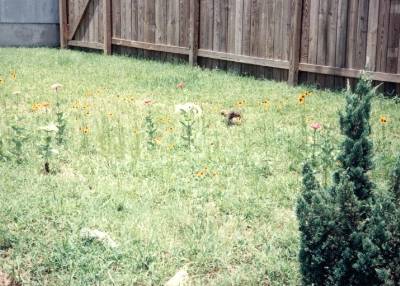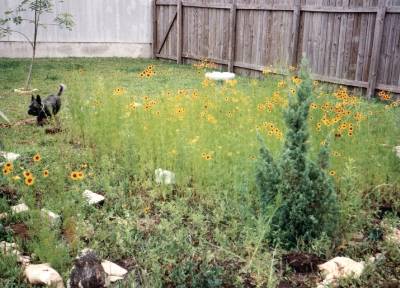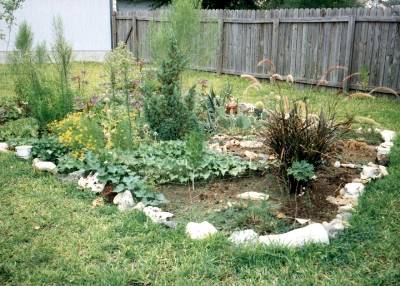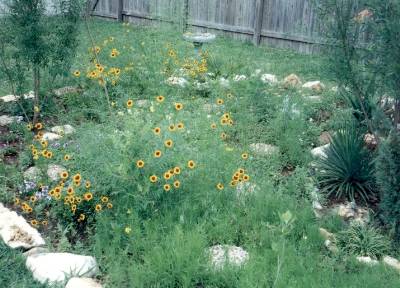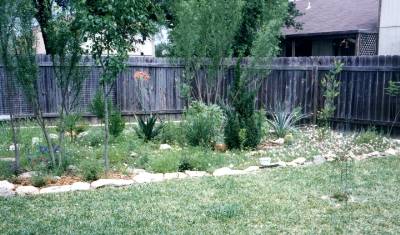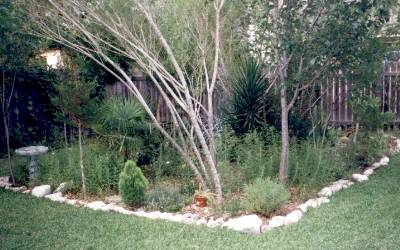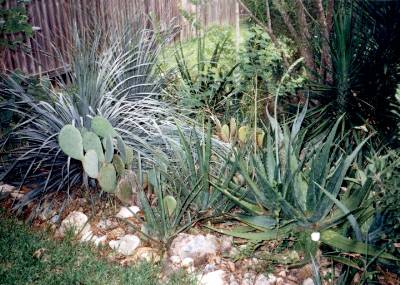Garden Gallery 4
Wildflower Garden
|
Early in our yard's history, we chose to fix a problem area by creating a garden in it. The 15 year evolution of this space has been a study in succession.
Above is the earliest photo we have of the wildflower garden. Taken in 1988, it shows a rather weedy area of our lawn with rocks placed around it to define where we were not to mow. Having noticed all the delightful spring wildflowers that grew in the vacant lots in our neighborhood, we decided to allow them to grow in part of our yard as well.
The changes in the form of the wildflower garden were slow at first, partly because that baking sunny area was not an attractive place in which to do yard work. By the date of the above photo, around 1990, we had added a birdbath. The flowers, especially coreopsis continued to bloom each spring and we basically ignored the area at other times of the year.
By 1992, as the above photo shows, we had finally made some major improvements in the garden. The rock rim was completed, stepping stones were added, and much of the grass was removed. The verdant vines are sweet potatoes, started from a cut up tuber. These plants not only produced exotic looking foliage, but we later dug up more sweet potatoes than we could possibly use. At this stage in our yard's development, I was anxious for any plants that were taller than 5 feet. The vertical interest provided by various wild plants, such as poverty weed was quite welcome.
Wildflowers continued to be the focus of this garden as the trees were growing very slowly and providing almost no shade. In the above photo, taken about 1994, annuals such as coreopsis continue to do well and we had added various succulents, such as the Spanish dagger yucca.
The garden, finally started to acquire some taller plants, such as an ornamental pear tree and the rapidly growing poverty weed, as shown in the above photo from around 1996. Since there was still plenty of sunshine, wildflowers continued to thrive, including bluebonnets and a large stand of primrose which can be seen on the right side of the garden.
By the time the above photo was taken in 1999, the garden was becoming much more shady. The poverty weed (which is the multi-trunked tree in the foreground) was near the end of its life and new shoots could not tolerate the lack of sun. The Spanish dagger (background center, dark green) was about 6 feet tall and would soon succumb to disease. Annuals no longer came up by themselves, but perennials such as copper canyon daisy, cherry sage, bergemot, and Mexican hat provided colorful blossoms.
In the above 2003 photo, all that is left of the poverty weed is a stump. The ornamental pear dominates the south portion of the garden but many of the other trees have also grown tall enough that they give ample headroom. The understory has become sparse but we are improving the soil and will continue to plant shade-loving perennials.
The northeast corner of the wildflower garden has long been devoted to desert plants. The above photo is from around 1994 and shows an established, but not yet overgrown, xeriscape area. The gray plants on the left are sotol and the giant aloe is blooming on the right. In between are spineless prickly pear cactus, yuccas, other cactus, lechuguillas and agaves.
The dramatic growth of the succulents is evident in the above photo from 1999. By this time, the sotol, lechuguilla, spineless prickly pear cactus and aloe have taken over. We have not seen the stepping stones in that area in years. The Spanish dagger, which appeared to be so healthy, rotted out at the bottom about a year later and the entire spiny plant fell over. The aloes suffered severe freeze damage in early 2003 when we failed to cover them with a sheet during an ice storm. However, they came back even thicker than before and continue to dominate their established territory.
|
